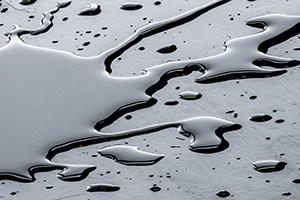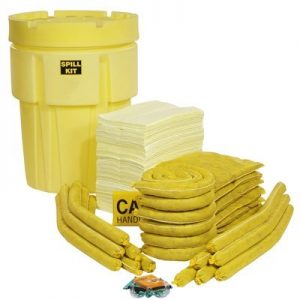Understanding the risks of chemical spills through safety planning
 Companies dealing with hazardous chemicals and materials should follow the old saying, “Hope for the best but prepare for the worst.” Let’s hope a spill never occurs but in the rare event that it does, be fully prepared to control, contain and clean it. Because when it comes to workplace safety, there is no room for compromise.
Companies dealing with hazardous chemicals and materials should follow the old saying, “Hope for the best but prepare for the worst.” Let’s hope a spill never occurs but in the rare event that it does, be fully prepared to control, contain and clean it. Because when it comes to workplace safety, there is no room for compromise.
Chemical spills can lead to a range of hazards, including fire, explosion, toxic fumes, and environmental contamination. These hazards can cause severe injuries or even fatalities, as well as significant damage to the surrounding environment. When companies turn a blind eye to the possibility of a hazardous chemical spill, they increase the chance of work-related injuries, while leaving themselves vulnerable to fines and sanctions handed down by the EPA.
Whether your company produces, transports, stores, or maintains hazardous chemicals, you need to take extra measures to ensure you are protected in the event of a spill. Some companies assume spill preparation isn’t necessary simply because they only store or transport chemicals rather than produce them. The bottom line is companies that deal with hazardous chemicals in any way, shape, or form must have a plan in place to reduce the impact of a spill.
So, let’s delve into the key steps you need to take to protect your workforce and minimize the potential impact of a chemical spill.
Importance of Comprehensive Safety Planning Against Chemical Spills
A comprehensive safety plan is the cornerstone of preparedness for hazardous chemical spills. It serves as a roadmap for your company, outlining the necessary procedures and protocols to follow in the event of a spill. A well-designed safety plan ensures that everyone in your organization knows their roles and responsibilities, reducing confusion and promoting a swift and organized response.
Furthermore, an effective safety plan should cover preventing hazardous chemical spills in the workplace. This includes guidelines on how to store chemicals safely, such as using appropriate containers and labeling systems. It should also outline the necessary precautions to minimize the risk of spills during transportation or use.
Identify Hazardous Chemicals In Your Workplace
The first step in preparing for a spill is to identify the types of hazardous chemicals present in your workplace. It’s not uncommon for companies to perform their day-to-day operations with little knowledge of the types of hazardous chemicals they are dealing with. When a spill occurs, they’re left scrambling to try and figure out the best way to contain it. A smarter approach is to identify the chemicals present in your workplace ahead of time, as this will allow you to better prepare for situations involving spills.
Start by reviewing the Safety Data Sheets (SDS) for each chemical. These documents provide detailed information on the hazards associated with each chemical, including its physical and chemical properties, health effects, and safety precautions.
Hazardous chemicals are often broken down into one of the following categories:
- Flammables
- Corrosives
- Oils
- Solvents
- Explosives
- Combustibles
Note: For more information on the different types of hazardous chemicals see our previous post, What is Hazardous Waste?
Understanding the potential hazards associated with each chemical–including flammability, reactivity, and toxicity–will help you determine the appropriate safety measures and response procedures to implement.
Identify Potential Spill Hazards and Risks
Next, you’ll want to evaluate your facility’s infrastructure and processes. Look for potential sources of chemical spills, such as faulty equipment, inadequate storage systems, or improper handling procedures. Assess the layout of your facility to identify areas where spills are more likely to occur, such as proximity to loading docks or chemical storage areas.
Engage your employees in this hazard identification process. They often have valuable insights and firsthand knowledge of potential risks. Encourage them to report any safety concerns or near misses related to chemical handling or storage. By actively involving your employees, you can create a culture of safety and enhance hazard awareness throughout your organization.
You should also consider the potential routes of exposure for employees and the surrounding community. Understanding how chemicals can be released into the environment will aid in developing effective containment and cleanup strategies. By thoroughly assessing the risks, you can take proactive steps to prevent chemical spills and mitigate their potential impact.
Create a Chemical Spill Response Plan
After identifying hazardous chemicals and risks in your workplace, you should then document a safety plan. Depending on the size and scope of your unique facility, this may require creating more than one type of plan. From a hazardous communications plan (HAZCOM) to one that is specific to fuel spill containment planning.
At a minimum, your safety plan should provide clear instructions on how to respond to a chemical spill. This includes steps to take immediately after a spill occurs, such as evacuating the area and notifying the appropriate authorities. It should also cover procedures for containing the spill, using appropriate personal protective equipment (PPE), and initiating the cleanup process.
Regular reviews and updates of your safety plan are crucial to ensure its effectiveness. As new chemicals are introduced or procedures change, it is essential to incorporate these updates into your plan. By consistently reviewing and improving your safety plan, you can stay ahead of potential hazards and enhance the overall preparedness of your company.
Creating an Emergency Response Team and Communication Plan
For large facilities, establishing an emergency response team will aid in a coordinated and efficient response to a hazardous chemical spill. This team should consist of individuals with specific roles and responsibilities, ensuring that all aspects of the response are covered.
Assign a team leader who will oversee the overall response efforts and act as the main point of contact for external agencies or authorities. Other team members may include individuals responsible for containment and cleanup, communication and coordination, and providing medical assistance if needed.
In addition to the emergency response team, you should develop a clear communication plan. This plan should outline how information will be disseminated during a chemical spill, both internally within your organization and externally to the appropriate agencies or authorities.
Consider establishing a chain of command for communication, ensuring that everyone knows who to contact and when. Implement a reliable communication system, such as two-way radios or a designated phone line, to facilitate quick and effective communication during emergencies. Regularly test the communication system to identify and address any potential issues.
Acquire Necessary Equipment for Spill Containment and Cleanup
Having the right equipment and materials readily available is essential for effective spill containment and cleanup. Depending on the nature and scale of the chemical spill, you will need a range of tools and resources to mitigate the risks and minimize the impact.
Invest in appropriate spill containment supplies, such as chemical absorbent materials, spill kits, and containment berms. These products are designed to quickly and effectively contain spilled chemicals, preventing further spread and contamination. Ensure that an ample supply of these materials is readily accessible throughout your facility.
For instance, companies dealing with large quantities of oil should invest in a spill kit specific to hydrocarbons. These spill kits include a variety of items necessary for containing and cleaning up oil-based chemicals, such as gasoline, diesel, motor oil, hydraulic oil, etc. On the other hand, workplaces with aggressive corrosives and solvent chemicals should opt for a hazmat spill kit or perhaps even an acid spill kit.
Also, equip your emergency response team with PPE suitable for handling hazardous chemicals. This may include gloves, goggles, respirators, and protective clothing. Regularly check and maintain the condition of the PPE, replacing any damaged or expired items. Likewise, it’s equally important to inspect your spill kit to validate the state of its contents.
Hazardous Chemical Spill Response Training: Know How to Use Spill Kits
Of course, a chemical spill kit is only useful if you’re fully aware of its contents and how to use them. Once you’ve acquired the appropriate spill kit, spend some time familiarizing yourself with its various supplies. Depending on the particular kit you choose, some of the items frequently contained include absorbent pads, socks, pillows, wipes, gloves, buckets, plastic bags, and emergency handbooks.
Properly trained employees are key to swift and effective hazardous chemical spill response. Without the necessary knowledge and skills, employees may panic or make uninformed decisions, potentially exacerbating the situation and increasing the risks.
Provide comprehensive training to all employees who may be involved in or affected by a chemical spill. This includes not only those directly working with hazardous chemicals but also individuals in adjacent areas who may need to take immediate action to protect themselves.
The training should cover various aspects of spill response, including recognition of different types of spills, the use of personal protective equipment (PPE), evacuation procedures, and communication protocols. Employees should also be familiar with spill kit locations and the proper use of spill containment and cleanup equipment.
Additionally, conduct regular drills and simulations to practice the response procedures outlined in your safety plan. These exercises will help identify any gaps or areas for improvement in your spill response capabilities. By continually reinforcing the training, you can ensure that your employees are prepared to handle a chemical spill confidently and minimize potential risks.
Stay Up to Date with Federal Requirements for Chemical Spills
In addition to implementing your safety plan, it is vital to comply with federal regulations and standards related to hazardous chemical spills. These regulations are in place to protect workers, the environment, and the general public from the dangers posed by chemical spills.
For example, the Occupational Safety and Health Administration (OSHA) Hazardous Waste Operations and Emergency Response (HAZWOPER) standard. This standard specifically outlines the requirements for employers and employees who respond to chemical spills or releases. Similarly, the Environmental Protection Agency (EPA) oversees a number of regulations related to chemicals and toxics, including the Resource Conservation and Recovery Act (RCRA) and Clean Water Act (CWA).
Failure to comply with federal regulations can result in severe penalties, legal liabilities, and reputational damage. By staying up to date with the latest regulations, you can maintain a safe and compliant working environment.
Conclusion
A hazardous chemical spill can have severe consequences for both human health and the environment. As a responsible company, it is crucial to prioritize safety and be prepared for such emergencies. By understanding the risks, implementing a comprehensive safety plan, having the right response equipment, complying with regulations, and training employees, you can minimize the potential impact of a chemical spill.
 Have questions about hazardous chemical spill supplies? Contact Travis Zdrazil at travis@absorbentsonline.com or (800) 869-9633.
Have questions about hazardous chemical spill supplies? Contact Travis Zdrazil at travis@absorbentsonline.com or (800) 869-9633.
This is a revision to a blog post with an original publication date of November 11, 2013.
